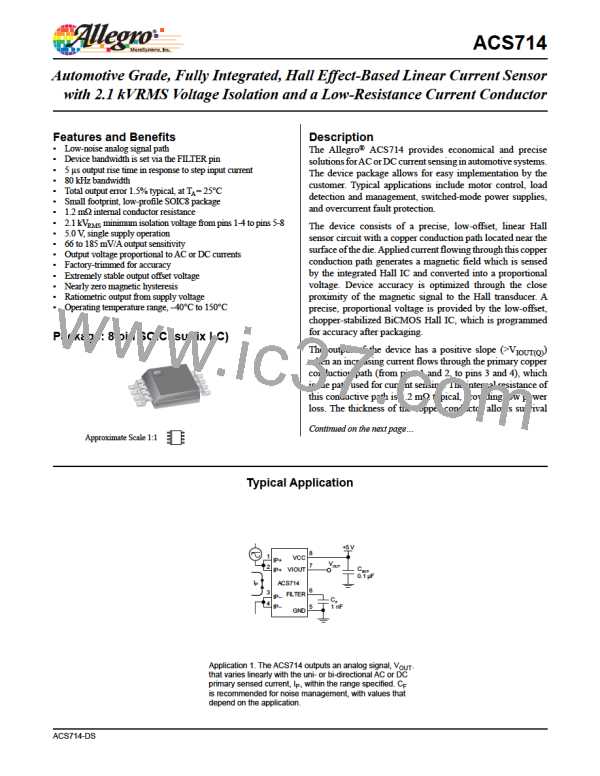Automotive Grade, Fully Integrated, Hall Effect-Based Linear Current Sensor
with 2.1 kVRMS Voltage Isolation and a Low-Resistance Current Conductor
ACS714
Definitions of Accuracy Characteristics
Sensitivity (Sens). The change in sensor output in response to a
1A change through the primary conductor. The sensitivity is the
product of the magnetic circuit sensitivity (G/A) and the linear
IC amplifier gain (mV/G). The linear IC amplifier gain is pro-
grammed at the factory to optimize the sensitivity (mV/A) for the
full-scale current of the device.
Accuracy is divided into four areas:
• 0 A at 25°C. Accuracy of sensing zero current flow at 25°C,
without the effects of temperature.
• 0 A over Δ temperature. Accuracy of sensing zero current
flow including temperature effects.
• Full-scale current at 25°C. Accuracy of sensing the full-scale
current at 25°C, without the effects of temperature.
Noise (VNOISE). The product of the linear IC amplifier gain
(mV/G) and the noise floor for the Allegro Hall effect linear IC
(≈1 G). The noise floor is derived from the thermal and shot
noise observed in Hall elements. Dividing the noise (mV) by the
sensitivity (mV/A) provides the smallest current that the device is
able to resolve.
• Full-scale current over Δ temperature. Accuracy of sensing full-
scale current flow including temperature effects.
Ratiometry. The ratiometric feature means that its 0 A output,
VIOUT(Q), (nominally equal to VCC/2) and sensitivity, Sens, are
Linearity (ELIN). The degree to which the voltage output from
the sensor varies in direct proportion to the primary current
through its full-scale amplitude. Nonlinearity in the output can be
attributed to the saturation of the flux concentrator approaching
the full-scale current. The following equation is used to derive the
linearity:
proportional to its supply voltage, VCC.The following formula is
used to derive the ratiometric change in 0 A output voltage,
ΔVIOUT(Q)RAT (%).
V
IOUT(Q)VCC / VIOUT(Q)5V
100
VCC
/
5 V
V
– VIOUT(Q)
) [ {
Δ gain × % sat (
IOUT_full-scale amperes
2 (VIOUT_half-scale amperes – VIOUT(Q)
100
1–
The ratiometric change in sensitivity, ΔSensRAT (%), is defined as:
{
[
)
SensVCC / Sens5V
where VIOUT_full-scale amperes = the output voltage (V) when the
sensed current approximates full-scale ±IP .
100
VCC
/
5 V
‰
ꢀ
Symmetry (ESYM). The degree to which the absolute voltage
output from the sensor varies in proportion to either a positive
or negative full-scale primary current. The following formula is
used to derive symmetry:
Output Voltage versus Sensed Current
Accuracy at 0 A and at Full-Scale Current
Increasing VIOUT(V)
Accuracy
Over $Temp erature
VIOUT_+ full-scale amperes – VIOUT(Q)
100
V
IOUT(Q) – VIOUT_–full-scale amperes
Accuracy
25°C Only
Quiescent output voltage (VIOUT(Q)). The output of the sensor
when the primary current is zero. For a unipolar supply voltage,
it nominally remains at VCC ⁄ 2. Thus, VCC = 5 V translates into
VIOUT(Q) = 2.5 V. Variation in VIOUT(Q) can be attributed to the
resolution of the Allegro linear IC quiescent voltage trim and
thermal drift.
Average
V
IOUT
Accuracy
Over $Temp erature
Accuracy
25°C Only
IP(min)
Electrical offset voltage (VOE). The deviation of the device out-
put from its ideal quiescent value of VCC / 2 due to nonmagnetic
causes. To convert this voltage to amperes, divide by the device
sensitivity, Sens.
–IP (A)
+IP (A)
Full Scale
I
P(max)
0 A
Accuracy (ETOT). The accuracy represents the maximum devia-
tion of the actual output from its ideal value. This is also known
as the total ouput error. The accuracy is illustrated graphically in
the output voltage versus current chart at right.
Accuracy
25°C Only
Accuracy
Over $Temp erature
Decreasing VIOUT(V)
Allegro MicroSystems, Inc.
115 Northeast Cutoff, Box 15036
11
Worcester, Massachusetts 01615-0036 (508) 853-5000
www.allegromicro.com

 ALLEGRO [ ALLEGRO MICROSYSTEMS ]
ALLEGRO [ ALLEGRO MICROSYSTEMS ]